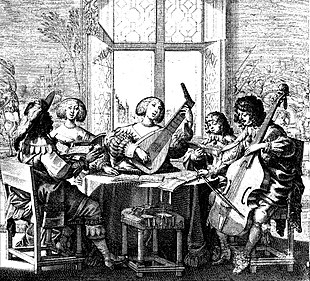Chamber music
The term chamber music originally referred to music that, in contrast to church music, was intended for the princely "chamber", ie for secular, representative use. It was only in the course of the Baroque that the term was limited to pure, small instrumental music . From classical music on , there is also an explicit demarcation from the burgeoning concert music . The most well-known genres of classical chamber music are string quartet and piano trio . In the Romantic era , chamber music experienced a concertante and virtuoso expansion of the existing musical means.
Today's definition is changing
Chamber music usually refers to a line-up of two to nine players - that is, ensembles from duo to nonet . However, especially in new music, large ensembles often have up to 25 players and thus border on chamber orchestras . Wind or string quartets are clearly part of it. Others differentiate according to the instrumental combination or the composition technique. For chamber music in the narrower sense, it is essential that it is first played by instrumentalists who are solely responsible (voices are never doubled) and secondly not conducted , so that the players find each other independently.
Chamber music today is understood to mean music for small instrumental ensembles as opposed to music for orchestras , whereby the transition between the genres is fluid - for example chamber orchestras and choirs , which are neither definitely small nor large and are usually also conducted. The chamber opera often consists of a small opera ensemble (chamber orchestra, small choir, a few soloists).
However, the term chamber music has been changing over the past 20 years. Influenced by recent research and the widespread use of baroque music in the mainstream of classical music , chamber music can be found today, especially for larger ensembles, to a greater extent than classical “concert music” with terms such as “chamber music sound” and “chamber music responsibility” now was the case.
Vocal chamber music is understood to mean vocal music and arrangements for the formation of smaller vocal ensembles .
The term is sometimes confused with house music .
Typical genres and occupations

- Sonata for melody instrument and figured bass
- Trio sonata
- Chamber music for one melody instrument alone
- Chamber music for one melody and one keyboard instrument (piano)
- Piano trio
- Piano trio with wind instruments
- Piano quartet
- Piano quintet
- Piano quintet with wind instruments
- Piano sextet
- Piano septet
- Horn trio
- Chamber music with harp
- String trio
- Trio with brass section
- Brass trio
- String quartet
- Quartet with winds (e.g. flute quartet )
- String quintet
- Wind quintet ( woodwind quintet , brass quintet )
- String sextet
- Sextet with brass section
- Septet
- Octet with brass section
- Nonet with horns
- Decett with horns
- String octet and double quartet
- Chamber music for wind instruments
- Chamber music for voices
- Chamber cantata (see cantata )
- Chamber symphony
Chamber music festivals
Well-known chamber music festivals in German-speaking countries are:
- Kyburgiade in Kyburg and Winterthur
- Allegro Vivo in the Waldviertel
- Lockenhaus Chamber Music Festival
- Eckelshausen Music Days in Central Hesse
- GAIA music festival in Thun
- Swiss Chamber Music Festival in Adelboden
- Styrian chamber music festival
- CLASSIX Kempten
See also
Individual evidence
- ↑ Max Nyffeler: Challenge Chamber Music: On the unbroken topicality of a historical genre , in "kontra.", Journal for Sound, Movement and Language, No. 6/2006, Conservatory / Private University Vienna.
